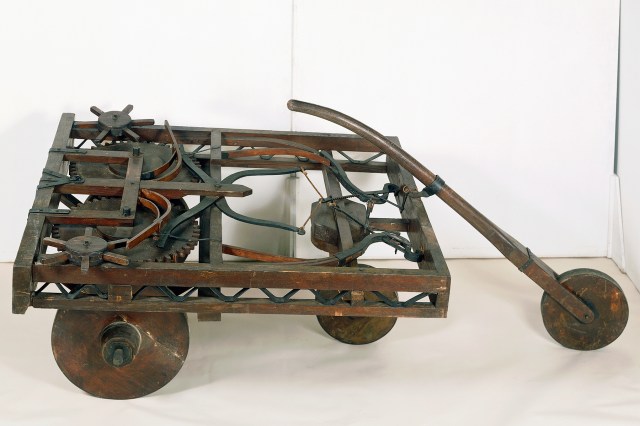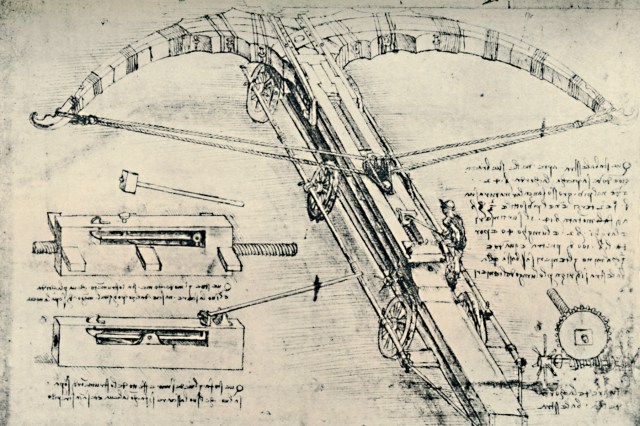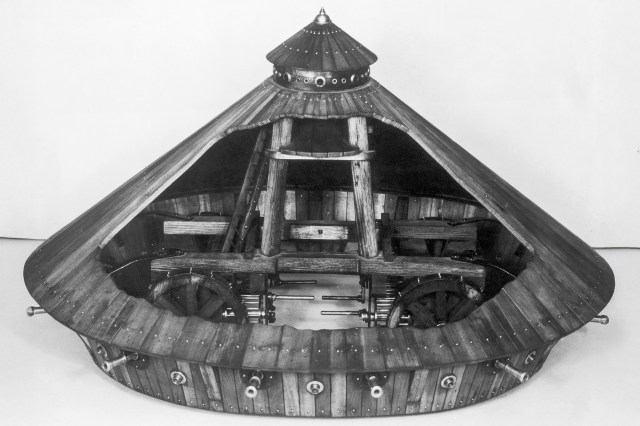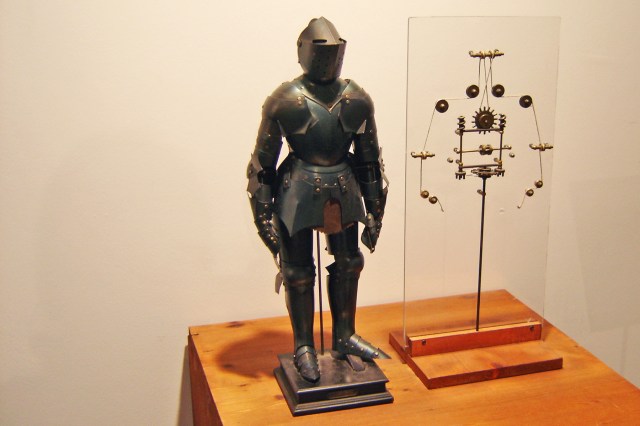
Ornithopter Flying Machine
Leonardo was fascinated by flight, and human flight in particular. In his notebooks, or codices, he produced more than 35,000 words and 500 sketches dealing with the nature of air, bird flight, and conceptual flying machines. Among them was the design for an ornithopter, a mechanical flying machine designed to stay in the air by the flapping of its wings in imitation of birds.
Leonardo’s sketches, which show a pilot-operated machine with flapping wings and complex mechanical joints, predate the modern understanding of aerodynamics by centuries. His fascination with flight led him to design other aerial contraptions, including an aerial screw (often considered a precursor to the modern helicopter) and a parachute built of wood and canvas.

Self-Propelled Cart
Not content with designing the precursors to modern flying machines, Leonardo also invented what can be seen as the ancestor of the modern automobile. His cart design was not only self-propelled, but also had a programmable steering mechanism and a system of gears and springs that could move independently — a remarkable piece of conceptual engineering for the time. In 2004, a team of scientists from the Museo Galileo in Florence built a working model based on Leonardo’s design, proving that it could work over distances of around 40 meters (roughly 130 feet).

Diving Suit
Long before scuba equipment was invented, Leonardo was designing diving suits with impressive detail. His notes include several drawings of different diving apparatuses, with the most comprehensive design featuring a leather suit, a face mask with goggles, an inflatable wineskin to enable sinking and floating, and two hollow breathing tubes that led from the diver’s mouth up to the surface of the water.
Leonardo created the diving suit with a military purpose in mind. At the time, he was living in Venice, a city surrounded by water and under threat from the Ottoman Empire. He envisioned the suit being used for underwater raids on the Ottoman fleet, with divers walking along riverbeds or seabeds to drill holes in the bottom of enemy ships. Such raids were never carried out, but when researchers for a BBC documentary built and tested the suit, they found that it could have worked as Leonardo planned.
More Interesting Reads

Giant Crossbow
In his Codex Atlanticus, Leonardo drew a series of schematics for shooting weapons. The most impressive was his giant crossbow, which measured some 75 feet in length with arms that were 80 feet wide when fully opened. Through a complex system of gears, cranks, and tension mechanisms, the crossbow was designed to fire large stones or possibly flaming bombs rather than giant arrows.
It was meant to be a shock-and-awe weapon — a hugely intimidating armament that would deter enemies from ever attacking. The colossal crossbow was never built, but the design is nonetheless a showcase for Leonardo’s unique understanding of mechanical and structural engineering.

Armored Vehicle
Another example of Leonardo’s military engineering was his design for an armored vehicle — often described as a prototype of the modern tank. Leonardo designed the armored car in the 1480s while under the patronage of Ludovico Sforza, Duke of Milan, one of Italy’s most powerful military leaders. In a letter to Sforza, he described how he would make “armored cars, totally unassailable, which will penetrate the ranks of the enemy with their artillery, and there is no company of soldiers so great that it can withstand them.”
The conical design of the tank was inspired by the shell of a turtle. Inside, eight people would turn cranks to drive the vehicle in any direction, while cannons projected out around the circumference of the vehicle, allowing it to fire in any direction.

Mechanical Knight
One of Leonardo’s strangest inventions was a humanoid mechanical knight. Designed in the late 15th century, it consisted of a medieval suit of armor with a set of gears and pulleys inside rigged to mimic human motion. The figure was capable of sitting up, moving its arms and legs, and opening and closing its jaw. Unlike most of Leonardo’s inventions, the robotic knight may have actually been built, most likely for entertaining guests at parties thrown by his wealthy patron.
In the 2000s, two separate attempts were made to re-create the mechanical knight, one by robotics expert Mark Rosheim and another by artist and Leonardo da Vinci aficionado Mario Taddei. Both followed the inventor’s sketches and instructions, and both attempts successfully brought the mechanical knight to life.












